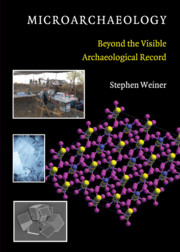Book contents
- Frontmatter
- Contents
- Preface
- 1 Archaeology, Archaeological Science, and Microarchaeology
- 2 Information Embedded in the Microscopic Record
- 3 Completeness of the Archaeological Record
- 4 Common Mineral Components of the Archaeological Record
- 5 Biological Materials: Bones and Teeth
- 6 Biological Materials: Phytoliths, Diatoms, Eggshells, Otoliths, and Mollusk Shells
- 7 Reconstructing Pyrotechnological Processes
- 8 Biological Molecules and Macromolecules: Protected Niches
- 9 Ethnoarchaeology of the Microscopic Record: Learning from the Present
- 10 Absolute Dating: Assessing the Quality of a Date
- 11 Reading the Microscopic Record On-Site
- 12 Infrared Spectroscopy in Archaeology
- Appendix A Identifying Minerals Using Microchemical Analysis
- Appendix B Identifying Minerals and Compounds Using Infrared Spectra: Table of Standard Minerals and Compounds for Which Infrared Spectra Are Available
- References
- Index
- Plates section
7 - Reconstructing Pyrotechnological Processes
Published online by Cambridge University Press: 05 June 2012
- Frontmatter
- Contents
- Preface
- 1 Archaeology, Archaeological Science, and Microarchaeology
- 2 Information Embedded in the Microscopic Record
- 3 Completeness of the Archaeological Record
- 4 Common Mineral Components of the Archaeological Record
- 5 Biological Materials: Bones and Teeth
- 6 Biological Materials: Phytoliths, Diatoms, Eggshells, Otoliths, and Mollusk Shells
- 7 Reconstructing Pyrotechnological Processes
- 8 Biological Molecules and Macromolecules: Protected Niches
- 9 Ethnoarchaeology of the Microscopic Record: Learning from the Present
- 10 Absolute Dating: Assessing the Quality of a Date
- 11 Reading the Microscopic Record On-Site
- 12 Infrared Spectroscopy in Archaeology
- Appendix A Identifying Minerals Using Microchemical Analysis
- Appendix B Identifying Minerals and Compounds Using Infrared Spectra: Table of Standard Minerals and Compounds for Which Infrared Spectra Are Available
- References
- Index
- Plates section
Summary
Humans have used fire for at least half a million years, and possibly a million or more years (Brain and Sillen, 1988; James, 1989; Weiner et al., 1998; Goren-Inbar et al., 2004). During this entire period, the most common use of fire was presumably for cooking food, for producing light and warmth, and for protection. It was only about 15,000 to possibly 18,000 years ago that fire was used for the first time to produce synthetic materials: plaster in the southern Levant (Kingery et al., 1988; Valla et al., 2007) and ceramics in south China and Japan (Yasuda, 2002; Boaretto et al., 2009c). All deliberate uses of fire by humans are referred to here as pyrotechnology. This behavior is one of the unique attributes of our species. Pyrotechnological practices are therefore of much interest when reconstructing human behavior.
Pyrotechnology is based on the fact that heat causes a usually atomically ordered natural material to lose its order, change its form, and then, on cooling, adopt another arrangement of atoms that results in the new material having different properties. Cooking is perhaps the most widespread and ancient form of pyrotechnology. In the case of plaster, ceramics, metals, and glasses, the new material can also be conveniently shaped. The shaping capability, together with the advantageous material properties, are the main functional and/or aesthetic benefits of producing traditional synthetic materials.
Information
- Type
- Chapter
- Information
- MicroarchaeologyBeyond the Visible Archaeological Record, pp. 165 - 206Publisher: Cambridge University PressPrint publication year: 2010
